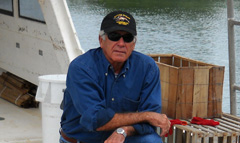Here we go again. Two years of grants, studies, hearings, and environmental posturing, before we go into a ten year rebuilding plan to save hogfish. All mandated, of course, by the Magnuson-Stevens Act – the magna carta of fishery bureaucrats in America. The happy days never end for fishery regulators, as they find species after species to keep their empire growing.
Unlike many other species, the hogfish population is a relatively simple one to control. It is basically a fish taken by spear, rather than hook and line. In 60 years of fish house operation, the amount of hogfish taken by hook and line fishermen puts it firmly into the bottom level of the by-catch category. The chance of harming the hogfish stock through hook and line fishing is zero.
It is also true that the number of commercial divers who depend on spearing hogfish for a living is very small. Observing the few divers who bring their catch to Stock Island Lobster Company, my own diving experience is validated by the limited amount and small size of the hogfish I see brought in for sale.
Recently, while free diving in South Atlantic waters near Geiger Key, I saw dozens of small hogfish. I didn’t see one large enough to shoot in an hour and a half dive, but it did convince me that while the stocks do not appear to be in danger, they could definitely use a size upgrade. For a number of years I have had a similar experience with seeing large numbers of small fish in Gulf of Mexico waters, though we were always able to find a few larger ones to eat.
So what we are really dealing with, is a species of fish that has been downsized by recreational spearfishing, and several quick fix possibilities present themselves.
1) Increase the size limit. Twelve inches is a good size for many fish, but yields a very small edible fillet on a hogfish. Fifteen or sixteen inches would probably be a good size to maintain a healthy stock. In 50 years of spearfishing around Key West, I have probably shot as many hogfish as anyone, but would never take a twelve inch one, unless I was starving for dinner. There is also a very limited market for that size, as the yield per cleaning effort is very poor, and it takes a couple of fish to make a meal for one person. I don’t know of any commercial divers that would shoot such small fish, as the monetary return is also not worth the effort.
2) Stop spearfishing for a couple of years. I am always reluctant to take a fishery away completely, but a nice compromise might be to increase the size for spearing to eighteen or twenty inches, while leaving the hook and line limit at fifteen. Anyone who gets desperate for a bite of hogfish, can always go to a local restaurant and eat one imported from Mexico, where they are systematically wiping them out with giant fish traps.
3) Reduce the bag limit. Ten per person is a lot of hogfish. Two per person should provide a sufficient meal, especially if the size limit is increased.
The same rules should be implemented for both South Atlantic and Gulf of Mexico waters, and then any of these possibilities or combination of them would yield quick results for increasing the average size of fish.
With that said, we must look at the real danger from rule changes: The bureaucratic regulators that are making them! The first thing to understand is that we will go through the entire sacred process. After all, they are mandated by the Magnuson-Stevens Act or some other bit of opaque legislation, which requires them to follow the entire cumbersome procedure of enacting rule changes.
The real danger however, lies in the fact that none of their science is to be trusted. It does not mean that none of it is accurate, but their regulatory studies are usually designed towards a preordained conclusion, which leaves them all suspect. After 45 years of being involved in the regulatory process, I trust my own experience and instincts far more than any ‘scientific study’.
It is also true that the bureaucracy and the environmental activists that persistently urge them forward with ever more restrictions, are thinking years ahead of those being regulated. If hogfish was an important commercial species, I would be looking for the future ‘unintended consequences’, which in fact, only come as a surprise to the fishermen.
Based solely on what I read in the newspaper, this seems to be an issue where my own experience agrees that there is a fixable problem with the hogfish stock. Since I have no intention of becoming involved again in the regulatory process, nor of even researching the issues, my response as a newspaper informed citizen is to let the bureaucracy have at it, and see if they can screw up something this simple.









